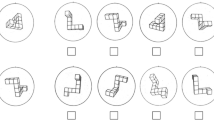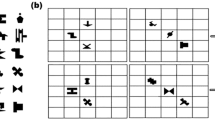Abstract
Thirty-two subjects were first submitted to a series of aptitude tests, then participated in a mental rotation task with advance information (Cooper, 1975), and finally gave retrospective reports about their solution strategy. The verbal reports showed that different subjects used different strategies to perform the rotation task, and also that some subjects shifted strategies, in that they successively adopted several ways of processing the same task. The coding of verbal reports led to distinguish five types of strategies (called rotation, partial rotation, verbal, projection, multiple). Five groups of subjects using preferentially one of these strategies were constituted. For each group hypotheses on performance were tested via analyses on reaction times and errors. These analyses confirmed that the five strategy groups produced different patterns of RT in conformity with verbal reports. Moreover the comparison of the mental aptitude profiles across the different strategy groups suggests that strategy choices are affected by steady and general characteristics of cognitive functioning.
Résumé
Trente-deux étudiants préalablement soumis à une batterie de tests mesurant différentes aptitudes (verbale, spatiale, raisonnement, ...) ont passé une tâche de traitement de l'information spatiale (Cooper, 1975). Les verbalisations produites par les sujets immédiatement après la passation ont montré qu'il existe une grande variabilité interindividuelle des stratégies mises en oeuvre pour réaliser la tâche, mais aussi que certains sujets adoptent successivement plusieurs modes de traitement. Sur la base des verbalisations 5 types de stratégies ont été identifiées (rotation, rotation partielle, verbale, projective, multiple), et 5 groupes de sujets utilisant préférentiellement l'une de ces stratégies ont été constitués. Pour chaque groupe, les hypothèses émises sur les traitements à partir de l'analyse des verbalisations ont ensuite été testées par des analyses de temps de traitement. Ces analyses ont permis de vérifier que les 5 groupes présentent des patterns de TR distincts et compatibles avec leurs verbalisations. Par ailleurs les relations observées entre les stratégies et les scores aux tests vont dans le sens de l'hypothèse selon laquelle des dimensions stables, plus générales du fonctionnement cognitif, affectent le choix d'une stratégie.
Similar content being viewed by others
References
Barratt, E.S. (1953). An analysis of verbal reports of solving spatial problems as an aid in defining spatial factors.The Journal of Psychology, 36, 17–25.
Bennett, G.K., Seashore, H.G., & Wesman, A.G. (1974).Manual for the Differential Aptitude Test. French version. Editions du centre de Psychologie appliquée. Paris: France.
Bethell-Fox, C.E., & Shepard, R.N. (1988). Mental rotation: Effects of stimulus complexity and familiarity.Journal of Experimental Psychology: Human Perception and Performance, 14, 12–23.
Bryden, M.P., George, J., & Inch, R. (1990). Sex differences and the role of figural complexity in determining the rate of mental rotation.Perceptual and Motor Skills, 70, 467–477.
Carpenter, P.A., & Just, M.A. (1986). Spatial ability: An information processing approach to psychometrics. In R. J. Sternberg (Ed.),Advances in the psychology of human intelligence (vol. 3, pp. 221–253). Hillsdale, NJ: Lawrence Erlbaum Associates.
Caverni, J.P. (1988). La verbalisation comme source d'observables pour l'étude du fonctionnement cognitif. In J.P. Caverni, C. Bastien, P. Mendelsohn, & G. Tiberghien (Eds.),Psychologie cognitive: Modèles et méthodes (pp. 253–274). Grenoble: Presses Universitaires de Grenoble.
Cooper, L.A. (1975). Mental rotation of random two-dimensional shapes.Cognitive Psychology, 7, 20–43.
Cooper, L.A. (1982). Strategies for visual comparison and representation: Individual differences. In R. J. Sternberg (Ed.),Advances in the psychology of human intelligence (vol. 1, pp. 77–124). Hillsdale, NJ: Lawrence Erlbaum Associates.
Cooper, L.A. (1988). The role of spatial representations in complex problem solving. In S. Schiffer & S. Steele (Eds.),Cognition and Representation (pp. 53–86). Boulder, CO: Westview Press.
Cooper, L.A., & Podgorny, P. (1976). Mental transformations and visual comparison processes: Effects of complexity and similarity.Journal of Experimental Psychology: Human Perception and Performance, 2, 503–514.
Cooper, L.A., & Shepard, R.N. (1973a). Chronometric studies of the rotation of mental images. In W.G. Chase (Ed.),Visual information processing (pp. 75–176). New York: Academic Press.
Cooper, L.A., & Shepard, R.N. (1973b). The time required to prepare for a rotated stimulus.Memory and Cognition, 1, 246–250.
Dean, A.L., & Scherzer, E. (1982). A comparison of reaction time and drawing measures of mental rotation.Journal of Experimental Child Psychology, 34, 20–37.
Egan, D.E., & Grimes-Farrow, D.D. (1982). Differences in mental representations spontaneously adopted for reasoning.Memory and Cognition, 10, 297–307.
Eme, P.-E. (1996).Stratégies individuelles de traitement de l'information spatiale. Doctoral thesis. Université Paris V René Descartes, Sciences Humaines, Sorbonne. (unpublished data).
Eme, P.-E., & Marquer, J. (1998). Quantitative and qualitative individual differences in visual comparison processing Are strategies only analytic or holistic?Personality and Individual Differences, 25, 459–475.
Ericsson, K.A., & Simon, H.A. (1993). Verbal reports as data.Psychological Review, 87, 215–250.
Ericsson, K.A., & Simon, H.A. (1993).Protocol analysis: Verbal reports as data. Cambridge, MA: MIT Press.
Estes, W.K. (1956). The problem of inference from curves based on group data.Psychological Bulletin, 53, 134–140.
Evans, J.St.B.T. (1990). Verbal reports of cognitive strategies: A note on Marquer and Pereira.The Quarterly Journal of Experimental Psychology, 42A, 169–170.
Feingold, A. (1992). Sex differences in variability in intellectual abilities: A new look at an old controversy.Review of Educational Research, 62, 61–84.
Fischer, S.C., Hickey, D.T., Pellegrino, J.W., & Law, D.J. (1994). Strategic processing in dynamic spatial reasoning tasks.Learning and individual differences, 6, 65–105.
Folk, M.D., & Luce, R.D. (1987). Effects of stimulus complexity on mental rotation, rate of polygons.Journal of Experimental Psychology: Human Perception and Performance, 13, 395–404.
French, J.W., Ekstrom, R.B., & Price, L.A. (1963).Kit of reference tests for cognitive factors. Princeton, NJ: Educational Testing Service.
Garner, R. (1988). Verbal-report data on cognitive and metacognitive strategies. In C.E. Weinstein, E.T. Goetz & P.A. Alexander (Eds.),Learning and Study Strategies (pp. 63–76). New York: Academic Press.
Gilles, P.Y. (1993).Etudes des stratégies individuelles dans la résolution de problèmes spatiaux. Doctoral thesis. Université Paris V René Descartes, Sciences Humaines. Sorbonne.
Hoc, J.M., & Leplat, J. (1983). Evaluation of different modalities of verbalization in a sorting task.International Journal of Man-Machine Studies, 18, 283–306.
Huteau, M. (1995).Manuel de psychologie différentielle. Paris: Dunod.
Just, M.A., & Carpenter, P.A. (1976). Eye fixations and cognitive processes.Cognitive Psychology, 8, 441–480.
Kail, R.V. (1991). Controlled and automatic processing during mental rotation.Journal of Experimental Child Psychology, 51, 337–347.
Kail, R.V., & Bisanz, J. (1982). Cognitive strategies. In C.R. Puff (Ed.),Handbook of research methods in human memory and cognition (pp. 229–255). New York: Academic Press.
Kosslyn, S.M., Brunn, J., Cave, K.R., & Wallach, R.W. (1984). Individual differences in mental imagery ability: A computational analysis.Cognition, 18, 195–243.
Kyllonen, P.C., Lohman, D.F., & Woltz, D.J. (1984). Componential modeling of alternative strategies for performing spatial tasks.Journal of Educational Psychology, 76, 1325–1345.
Lautrey, J. (1990). Esquisse d'un modèle pluraliste du développement cognitif. In M. Reuchlin, J. Lautrey, C. Marendaz, & T. Ohlmann (Eds.),Cognition: L'individuel et l'universel. Paris: Presses Universitaires de France.
Lautrey, J. (1995). Introduction. In J. Lautrey (Ed.),Universel et différentiel en psychologie. Paris: Presses Universitaires de France
Likert, R., & Quasha, W.H. (1970).Manual for the revised Minnesota paper form board test. French version. Editions du centre de Psychologie appliquée, Paris, France.
Lohman, D.F., & Kyllonen, P.C. (1983). Individual differences in solution strategy on spatial tasks. In R. Dillon (Ed.),Individual differences in cognition (vol. 1, pp. 105–135). New York: Academic Press.
Lohman, D.F. (1988). Spatial abilities as traits, processes and knowledge. In R.J. Sternberg (Ed.),Advances in the Psychology of Human Intelligence (vol. 4, pp. 181–248). Hillsdale, NJ. Lawrence Erlbaum Associates.
Marquer, J. (1990). Reaction times and verbal reports in the study of strategies: A reply to Evans.Quarterly Journal of Experimental Psychology, 42A, 171–172.
Marquer, J. (1995). Varaibilité intra- et interindividuelle dans les stratégies cognitives: L'exemple du traitement de couples de lettres.Universel et differentiel en psychologie (pp. 107–130). Paris: Presses Universitaires de France.
Marquer, J., & Pereira, M. (1990). Reaction times in the study of strategies in sentence-picture verification: A reconsideration.Quarterly Journal of Experimental Psychology, 42A, 147–168.
McGee, M.G. (1979). Human spatial abilities: Psychometric studies and environmental influences.Psychological Bulletin, 86, 889–918.
Nisbett, R.E., & Wilson, T.D. (1977). Telling more than we can know: Verbal reports on mental processes.Psychological Review, 84, 231–259.
Pachella, R.G. (1974). The interpretation of RT in information processing approach. In B. Kantowitz (Ed.),Human information processing: Tutorials in performance and cognition (pp. 41–82). Hillsdale, NJ: Erlbaum.
Palmer, S.E. (1977). Hierarchical structure in perceptual representation.Cognitive Psychology, 9, 441–474.
Peterson, P.L., Swing, S.R., Braverman, M.T., & Buss, R. (1982). Students' aptitudes and their reports of cognitive processes during direct instruction.Journal of Educational Psychology, 74, 535–537.
Reuchlin, M. (1978). Processus vicariants et différences individuelles.Journal de Psychologie Normale et Pathologique, 2, 133–145.
Robert, M. (1995). Fonctionnement cognitif et comparaisons inter-sexes. In J. Lautrey (Ed.),Universel et différentiel en psychologie (pp. 279–304). Paris: Presses Universitaires de France.
Roberts, M.J., & Erdos, G. (1993). Strategy selection and metacognition. Special Issue: Thinking.Educational Psychology, 13, 259–266.
Rozencwajg, P. (1991). Analysis of problem solving strategies on the Kohs Block Design Test.European Journal of Psychology of Education, 6, 73–88.
Russo, J.E., Johnson, E.J., & Stephens, D.L. (1989). The validity of verbal protocols.Memory and Cognition, 17, 759–769.
Schofield, N.J., & Kirby, J.R. (1994). Position location on topographical maps: Effects of task factors, training, and strategies.Cognition and Instruction, 12, 35–60.
Shepard, R.N., & Cooper, L.A. (1982).Mental images and their transformations. Cambridge, MA: MIT Press.
Siegler, R.S. (1987). The perils of averaging data over strategies: An exemple from children's addition.Journal of Experimental Psychology: General, 116, 250–264.
Siegler, R.S., & Campbell, J. (1989). Individual differences in children's strategy choice. In P.L. Ackerman, R.J. Sternberg, & R. Glaser (Eds.).Learning and individual differences (pp. 218–254). New York: Freeman.
Siegler, R.S., & Jenkins, E. (1989).How children discover new strategies. Hillsdale, NJ: Erlbaum.
Snow, R.E. (1978). Theory and method for research on aptitude processes.Intelligence, 2, 225–278.
Snow, R.E. (1980). Aptitude processes. In R.E. Snow, P.A. Federico, & W.E. Montague.Aptitude, learning and instruction: Cognitive process analyses (pp. 27–63). Hillsdale, NJ: Lawrence Erlbaum Associates.
Sternberg, R.J. (1977).Intelligence, information processing, and analogical reasoning: The componential analysis of human abilities. Hillsdale NJ: Lawrence Erlbaum Associates.
Sternberg, R.J. (1980). Representation and process in linear syllogistic reasoning.Journal of Experimental Psychology: General, 109, 226–239.
Sternberg, R.J. (1985).Beyong IQ: A triarchic theory of human intelligence. Cambridge: Cambridge University Press.
Thurstone, L.L., & Thurstone, T.G. (1947). Batterie factorielle, Primary Mental Abilities (PMA). Adaptation française. Editions du centre de Psychologie appliquée. Paris: France.
Wechsler, D. (1965).Wechsler adult intelligence scale. Adaptation française. Editions du Centre de Psychologie appliquée. Paris: France.
Witkin, H.A., Oltman, P.K., Raskin, E., & Karp, S.A. (1971).Embedded figures test. Palo Alto, CA: Consulting Psychologists Press.
Yuille, C.J., & Steiger, J. (1982). Nonholistic processing in mental rotation: Some suggesive evidence.Perception and psychophysics, 31, 201–209.
Author information
Authors and Affiliations
Rights and permissions
About this article
Cite this article
Eme, PE., Marquer, J. Individual strategies in a spatial task and how they relate to aptitudes. Eur J Psychol Educ 14, 89–108 (1999). https://doi.org/10.1007/BF03173113
Received:
Revised:
Issue Date:
DOI: https://doi.org/10.1007/BF03173113




